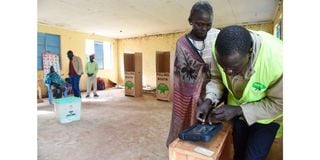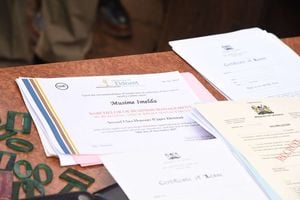IEBC defends voter turnout figure in response to Raila Odinga’s poll petition

An IEBC official uses a Kiems kit identify a voter at Shongen Primary School in Kacheliba, West Pokot County, on August 29, 2022.
What you need to know:
- IEBC says it can account for all ballot papers cast on August 9.
- IEBC has also rejected claims of significant variances between votes cast in other elective seats compared to that of President.
The electoral agency has come out to defend its voter turnout figure—a key determinant in knowing who won as well as a major plank in the Supreme Court case challenging the presidential elections—saying it can account for all ballot papers cast on August 9.
The Independent Electoral and Boundaries Commission (IEBC) has also rejected claims of significant variances between votes cast in other elective seats compared to that of President.
IEBC has also refuted allegations of manipulation of the voter turnout, adding that Azimio la Umoja One Kenya Coalition Party candidate Raila Odinga and his running-mate Martha Karua are using wrong calculations to dispute the election results.
“The number of voters authenticated through the Kiems kit is 14,239,862 in 45,994 polling stations. This translates to 22,005,541 registered voters. The number of voters authenticated using the complementary mechanism (printed register) in 229 polling stations is 86, 889,” IEBC says in court filings, dismissing claims of massive failure of the Kenya Integrated Election Management System (Kiems) kits.
According to IEBC, there are no variances in the figures used to declare William Ruto as the winner of the presidential election and all forms 34A used in the tallying exercise were verified and authentic. Furthermore, no variances were pointed out by agents of the presidential candidates.
Errors
“Presidential agents were allowed to point out errors and discrepancies in the forms and the said errors were first confirmed and then recorded in the error form. There was no variance reported on candidates tallying between the transmitted forms 34A by the presiding officer and the original forms 34s submitted by the returning officer,” IEBC’s Acting Director Voter Registration and Electoral Operations Moses Ledama says in an affidavit.
The affidavit is in response to discrepancies and variances complained of by Mr Odinga and Ms Karua in their petition.
Regarding Mr Odinga’s claim that the number of people who turned out to vote remains indeterminate and that the turnout was over 65.4 per cent, IEBC says the actual final turn out was 64.767 per cent. These were the voters identified using both the physical printed register and the Kiems kits in all the 46,229 polling stations. Total valid votes were 14,213,137, the total rejected votes were 113,614 while the registered voters were 22,120,458.
229 polling stations
Court papers further indicate that IEBC used the printed register to identify voters in 229 polling stations. Six other stations had challenges due to violence — three in Eldas and three in Khwisero. A total of 86,889 voters were authenticated using the printed register.
In response to allegation that more voters voted for Presidential election compared to the other elective seats, Mr Ledama says the variances can be accounted for. For instance, he says the prison and diaspora voters only voted for the President.
He further explains that the variance is because Woman Representative and governorship polls did not take place in Kericho (Woman Rep elected unopposed), Kakamega and Mombasa (governor elections postponed).
The variance is also attributed to stray ballots, violence in some polling stations and locking of some election result forms, such as in Mathare and Starehe Constituencies, in ballot boxes and refusal by candidates' agents to open the said boxes.





